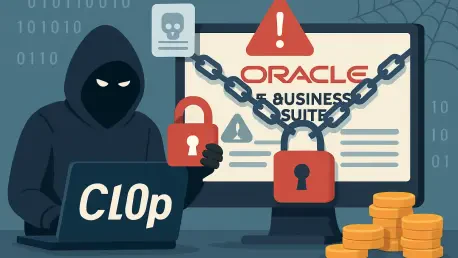In a chilling development for global enterprises, a critical zero-day vulnerability in Oracle’s E-Business Suite (EBS) has been actively exploited by the infamous Cl0p ransomware group, exposing thousands of organizations to severe risks of data theft and system compromise. Identified as CVE-2025-61882, this remote code execution flaw targets the Business Intelligence Publisher (BI Publisher) Integration component across EBS versions 12.2.3 to 12.2.14, earning a near-perfect CVSS score of 9.8 due to its potential for total system compromise. With Oracle EBS serving as the backbone for critical operations like order management and procurement in numerous industries, the scale of this threat cannot be overstated. An emergency security advisory from Oracle has urged immediate action, as attackers leverage this flaw to infiltrate systems worldwide. This alarming situation underscores the growing audacity of cybercriminal groups and raises urgent questions about the security of enterprise software relied upon by so many.
Emerging Threat Landscape with Cl0p’s Tactics
The sophistication of the Cl0p ransomware group, a notorious player in the cybercrime arena since early 2019, has reached new heights with this latest campaign targeting Oracle EBS systems. Linked to threat actors like TA505 and FIN11, Cl0p has a well-documented history of exploiting zero-day vulnerabilities in enterprise software, previously seen in attacks on platforms like Accellion and MOVEit Transfer. However, their approach has evolved significantly in this operation. Rather than focusing solely on encrypting files, the group has pivoted to data exfiltration and extortion, a tactic that maximizes financial gain without necessarily disrupting operations. Since early October, affected Oracle customers have received menacing emails claiming that sensitive data was stolen directly from their EBS environments. This strategic shift highlights a broader trend in ransomware attacks, where the emphasis is increasingly on leveraging stolen information to pressure victims into paying hefty ransoms.
Beyond the primary zero-day flaw, Cl0p’s exploitation toolkit in this campaign includes nine additional vulnerabilities that were addressed in Oracle’s recent Critical Patch Update. These secondary flaws, with CVSS scores ranging from 5.4 to 8.1, affect various EBS components such as Lease and Finance Management and Mobile Field Service, exposing a wide attack surface within Oracle’s ecosystem. The breadth of these vulnerabilities demonstrates how interconnected and complex enterprise systems can become prime targets for determined attackers. Oracle has provided patches for all identified issues, but the remediation process is not straightforward—organizations must first apply an earlier update as a prerequisite, adding layers of urgency and complexity to the response. This multifaceted attack strategy by Cl0p reveals the critical need for comprehensive security measures that address not just single flaws but entire systems prone to exploitation.
Technical Severity and Urgent Mitigation Needs
Diving deeper into the technical implications, the primary vulnerability, CVE-2025-61882, stands out as a catastrophic risk due to its capacity for remote code execution without authentication. This means attackers can gain full control over affected systems with minimal barriers, a scenario that has already played out across numerous organizations. What amplifies the danger further is the public availability of proof-of-concept exploits for this flaw, making it accessible to a wider pool of malicious actors beyond just sophisticated groups like Cl0p. Security experts have sounded the alarm, emphasizing that unpatched systems are essentially sitting ducks in the current threat environment. Oracle’s swift issuance of patches is a step in the right direction, yet the responsibility falls heavily on organizations to assess their exposure and implement updates without delay, a task often complicated by operational dependencies and resource constraints.
The broader implications of this incident point to a persistent challenge in securing enterprise software against zero-day threats. While Oracle has acted promptly with advisories and patches, the complexity of applying these fixes—especially under the pressure of active exploitation—poses a significant hurdle for many businesses. Beyond the immediate need to patch, there’s a growing recognition that organizations must adopt a proactive stance on cybersecurity. This includes regular vulnerability assessments, robust monitoring for unusual activity, and ensuring that critical systems are isolated from unnecessary external access. The reality is that Cl0p’s success in exploiting such flaws is a stark reminder of the escalating arms race between defenders and attackers. As ransomware groups refine their methods, the window for effective response continues to shrink, demanding agility and vigilance from every entity relying on platforms like Oracle EBS.
Navigating Future Risks and Strengthening Defenses
Reflecting on the fallout from this exploitation, it becomes evident that Cl0p’s targeted approach has reshaped the cybersecurity landscape for enterprise systems. Their blend of zero-day exploitation and extortion tactics has not only compromised sensitive data but also eroded trust in the security of widely used business platforms. The incident has served as a wake-up call, exposing gaps in preparedness that many organizations had overlooked until it was too late. Oracle’s response, though timely with patches and guidance, has placed significant pressure on customers to navigate a complex remediation process under the looming threat of further attacks.
Looking ahead, the path forward involves more than just addressing the immediate vulnerabilities that were exploited. Organizations must prioritize building resilient security frameworks, investing in real-time threat detection, and fostering a culture of rapid response to mitigate similar risks. Collaborating with security vendors for advanced threat intelligence and ensuring regular updates to critical systems can significantly reduce exposure. Additionally, simulating attack scenarios through red team exercises could help identify weaknesses before malicious actors do. This breach has underscored a critical lesson: staying ahead of evolving threats like those posed by Cl0p demands continuous adaptation and a commitment to safeguarding the digital backbone of modern enterprises.









